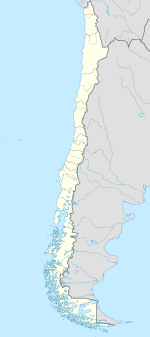La Ligua (Spanish pronunciation: [la ˈliɣwa]) is a city and commune that is the capital of Petorca Province in the Valparaíso Region. It is known for its textile manufacturing and traditional Chilean pastries.[citation needed]
La Ligua | |
|---|---|
 La Ligua | |
| Coordinates: 32°27′S 71°13′W / 32.450°S 71.217°W | |
| Country | |
| Region | |
| Province | Petorca |
| Founded | 1754 |
| Government | |
| • Type | Municipality |
| • Alcalde | Rodrigo Sánchez Villalobos |
| Area | |
| • Total | 1,163.4 km2 (449.2 sq mi) |
| Elevation | 126 m (413 ft) |
| Population (2012 Census)[2] | |
| • Total | 32,131 |
| • Density | 28/km2 (72/sq mi) |
| • Urban | 24,214 |
| • Rural | 7,773 |
| Sex | |
| • Men | 16,079 |
| • Women | 15,908 |
| Time zone | UTC-4 (CLT[3]) |
| • Summer (DST) | UTC-3 (CLST[4]) |
| Area code | 56 + 33 |
| Website | Official website (in Spanish) |
Demographics edit
According to data from the 2002 Census of Population and Housing, La Ligua had 31,987 inhabitants; of these, 24,214 (75.7%) lived in urban areas and 7,773 (24.3%) in rural areas. At that time, there were 16,079 men and 15,908 women.[2]
Administration edit
This article needs to be updated. (July 2022) |
As a commune, La Ligua is a third-level administrative division of Chile which is run by a communal council, and headed by a mayor who is directly elected every four years. The 2008–2012 mayor was Rodrigo Sánchez Villalobos. The communal council had the following members:[1]
- Hugo Díaz Tapia
- Ana Ardiles Saavedra
- María Teresa Cerda García
- Marisol Leiva Cortés
- Juan Yáñez Peña
- Ernesto Molina Miranda
Within the electoral divisions of Chile, La Ligua belongs to the 10th electoral district and 5th senatorial constituency.[citation needed]
References edit
- ^ a b "Municipality of La Ligua". Retrieved 28 July 2010.
- ^ a b c d "National Statistics Institute" (in Spanish). Retrieved 28 July 2010.
- ^ "Chile Time". WorldTimeZones.org. Archived from the original on 2007-09-11. Retrieved 2010-07-28.
- ^ "Chile Summer Time". WorldTimeZones.org. Archived from the original on 2007-09-11. Retrieved 2010-07-28.
External links edit
- (in Spanish) Municipality of La Ligua


